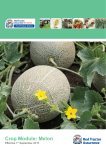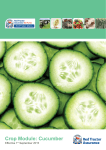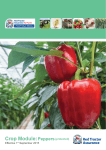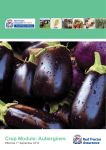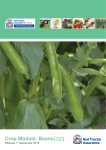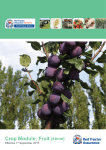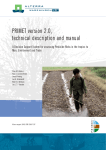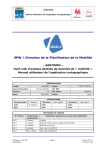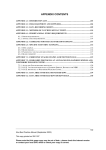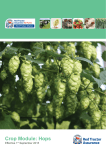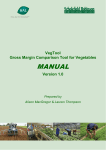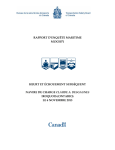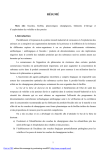Download Crop Module: Chilli Peppers
Transcript
Crop Module: Chilli Peppers Effective 1st September 2015 Welcome T his crop specific module for chilli peppers has been written to complement and avoid duplicating the generic principles of the Red Tractor Farm Assurance Fresh Produce Scheme standards. It is advisable to read the Red Tractor Farm Assurance Fresh Produce standards before reading this crop specific module. This module is designed to stimulate thought in the mind of the reader. It contains crop specific guidance and standards, where applicable, in addition to the requirements stated in the generic Fresh Produce standards. Within this module the important requirements outlined in the crop specific standards section will be verified during the Red Tractor Farm Assurance assessment and compliance will form a part of the certification/approval decision. Disclaimer and trade mark acknowledgement Although every effort has been made to ensure accuracy, Assured Food Standards does not accept any responsibility for errors and omissions. Trade names are only used in this module where use of that specific product is essential. All such products are annotated® and all trademark rights are hereby acknowledged. General Introduction Following a systematic approach will help growers identify and manage the risks involved in crop production. This module is based on a typical crop production process and food safety, health & safety, environmental and quality hazards are identified. Appropriate controls may then be established to minimise risk. Food safety and health & safety issues always take precedent over quality and environmental controls. The layout of this module follows the same structure as that used in the Red Tractor Farm Assurance Fresh Produce Standards. The content of the module is reviewed prior to the issue of updated editions. The review process considers both new developments and all relevant technology which has emerged since the last review was completed and which have been found to be both workable by the grower and beneficial to the environment. The aim is to transfer such information and technologies to growers. Acknowledgements Red Tractor Farm Assurance Fresh Produce gratefully acknowledges the contribution of all consultees in the preparation of this protocol, particularly Debbie M Johnson. Notes: Pesticide Information The Red Tractor Fresh Produce team has been working with Fera to provide tailored access to the LIAISON database for all Red Tractor Fresh Produce members. This system allows individual growers access to all information for plant protection products approved for use under the Red Tractor Fresh Produce Scheme. LIAISON can be accessed under the Produce tab via the “Checkers and Services” page where you will also find a user manual. Searches will be filtered specifically for the crops for which you are registered. Once you have logged onto the site and clicked on the LIAISON hyperlink you will be directed to the LIAISON home screen. You will need a username and password and these will be sent once you have registered: http://assurance.redtractor.org.uk/rtassurance/ services/Registration/members.eb . Front cover image credit: Debbie Johnson, Westshore Chillies. 1 Red Tractor Assurance for Farms – Crop-specific Module: Peppers (Chilli) © Assured Food Standards 2015 Content Contents ADDITIONAL REQUIREMENTS AGAINST CURRENT STANDARDS 02 CROP SPECIFIC STANDARDS02 CHOICE OF VARIETY OR ROOTSTOCK AND PLANT HEALTH CERTIFICATION 03 SITE AND SOIL MANAGEMENT 03 ENVIRONMENTAL PROTECTION AND CONTAMINATION CONTROL03 PEST, DISEASE AND WEED CONTROL 04 NUTRITION 08 RESIDUES AND CONTAMINANTS08 ADDITIONAL REQUIREMENTS AGAINST CURRENT STANDARDS None for this crop module CROP SPECIFIC STANDARDS STANDARDS HOW YOU WILL BE MEASURED CQ.65.a n There must be designated areas for eating/ drinking/ smoking which are separate to the cropping areas n Cropping RECORDS (to be kept for 2 years) Designated areas are clearly signed areas are clearly signed with ‘no eating/ drinking/ smoking’ signs n CQ.65.b Records must be kept of introduction of biological control agents n Feed CQ.65.c tanks should be bunded to reduce leakage Steps must be taken to minimise nutrient run off into soil and water courses Written procedures must be in place in case of an oil spillage n Records of run-off of volume n Run-off sample analysis records n CQ.65.d iological control B introduction records dequate procedure to prevent A environmental contamination Red Tractor Assurance for Farms – Crop-specific Module: Peppers (Chilli) n Records of oil spillages © Assured Food Standards 2015 2 GUIDANCE CHOICE OF VARIETY OR ROOTSTOCK AND PLANT HEALTH CERTIFICATION PROPAGATION Growers should formalise the supply contract with their propagators, stipulating pesticides that can be used. Growers should visit the propagator to inspect his plants. Growers ensure the supplier adheres to the contractual requirements by requesting crop treatment records and making inspection visits. Plants should be carefully inspected on delivery and any concerns/complaints notified immediately to the propagator. Propagators should be members of an audited scheme such as Global.G.A.P. to ensure quality and health standards. SITE AND SOIL MANAGEMENT New Crop Establishment For soil grown crops, the soil should be sterilised with steam, or other suitable sterilant, as and when necessary for control of weeds and root diseases. Annual treatment will generally be necessary to reduce the risk of root diseases. Greenhouses should be washed down, old sticky traps, strings and irrigation tape removed and replaced. As soon as the new crop arrives further sticky traps should be hung in each glasshouse and these should be assessed regularly to monitor the pest situation. Trays containing the new season’s plants should be placed only on a clean surface (e.g. new polythene, disinfected and rinsed concrete). Hygiene “No smoking/No food” signs must be displayed on glasshouses and staff must be provided with clearly defined areas in which to eat and drink. Staff should be informed of the effects and the need to follow hygiene measures after handling damaged fruit. 3 Use of bumblebee pollinators in protected crops The bumblebees used for pollinating protected salad crops are of a species which is not native to the UK and can only be supplied and used under a licence from Natural England. Growers using bumblebees will be made aware by the suppliers of the requirements necessary to comply with this licence and should adhere to these requirements. ENVIRONMENTAL PROTECTION & CONTAMINATION CONTROL THE BASIC APPROACH TO CROP PROTECTION Key principles of integrated crop management 1. Biological, environmental and cultural methods of pest and disease control must be used as the first line of defence. 2. Chemical pesticides are to be used only when biological controls are not available or shown not to be working. 3. The crops should be monitored at least weekly and records made of pest, disease and biological control organism levels. 4. Records must be kept of introduction of biological control agents. 5. Climate control computers should be used to ensure a suitable environment is maintained at all times. 6. Records must be kept of all pesticide applications. Adaptation for new pests and diseases The occurrence of a new disease or pest problem is largely unpredictable. It may arise, for example, when a previously non-indigenous disease or pest becomes established in the UK with a change in variety or cropping practice (e.g. switch from soil to substrate cropping) or when a pathogen/pest previously controlled by a particular pesticide develops resistance. In all these situations it may be necessary to implement additional pesticide treatments. Red Tractor Assurance for Farms – Crop-specific Module: Peppers (Chilli) © Assured Food Standards 2015 A proposed schedule for controlling ‘new’ pest or disease problems, in order of priority, is described below: The key objective is that the organism is controlled by means of a change in glasshouse environment, crop culture, biological or other non-chemical method. In some situations however, it is possible that additional use of pesticides may be necessary, at least in the short term or until a suitable alternate variety with genetic resistance is available. Such new varieties should be incorporated into the cropping programme, as they become available, providing they meet the end-market specifications. In service training Training in identification of pests and diseases, their damage and their biological controls and an appreciation of the objectives of this protocol should be given to each new member of staff. All staff working on the nursery, both regular and casual, should be instructed as necessary to satisfy COSHH requirements with respect to pesticide treatments, and to satisfy the requirements of the General Food Hygiene Regulations. The ‘new’ pest or disease situation may be controlled with the biological control measures. Regular crop inspections If none of these pesticides provide effective control, advice should be sought on a suitable alternative product, currently approved for use on the appropriate protected crop under Control of Pesticides Regulations (1986). Monitoring INTEGRATED CROP MANAGEMENT TRAINING Pest and disease identification Staff working regularly on protected crops should be able to recognise the following pests and diseases: Powdery mildew Downy mildew Botrytis (grey mould) on leaves, stems and fruit Black stem rot (Didymella syn. Mycosphaeralla) Penicillium stem rot Pythium root and stem base rot Various relevant virus diseases Glasshouse whitefly Spider mites and other mites Caterpillar damage Leaf miner damage Thrips Staff should know who to report to when the above pests and diseases, or other problems regularly found on a particular nursery, are first detected during the season. Managers and supervisors should appreciate the relative risk to their crops from the relevant pests and diseases. Monitoring of diseases is of vital importance. It is essential that all crops are walked at least once a week and records kept of each inspection. All nursery staff should be alert to fresh pest or disease symptoms or signs of imbalance with biological control mechanisms. PEST, DISEASE AND WEED CONTROL SPECIFIC HYGIENE MEASURES Previous cropping A high volume insecticide spray should be applied to the remnants of the previous crop at the last practical opportunity using a short persistence synthetic pyrethroid insecticide. At the end of cropping, fog or fumigate the crop with a suitable disinfectant. Remove the crop, weeds and all debris within 2 days of treatment, and dispose of them by removing off site (ensure the load is covered). The plastic sheeting should be removed where possible, as the risk of carry-over of disease organisms has to be carefully considered in relation to its re-use on site. Wash down the glass and the structure inside the glasshouse and then treat with a suitable disinfectant (e.g. Panacide®, Ter-Special®, Jet 5® or Zal®). In the cases of previous leaf miner or leafhopper problems, a high volume spray of a synthetic pyrethroid insecticide should be applied to bare ground, walls and structure when all equipment has been removed. Persistent pyrethroid insecticides should not be used because of their possible effects on biological control agents. In the case of previous whitefly problems, fumigate the empty glasshouse with nicotine. Warm climatic conditions are necessary for successful fumigation. Red Tractor Assurance for Farms – Crop-specific Module: Peppers (Chilli) © Assured Food Standards 2015 4 Equipment Exterior Thoroughly clean picking boxes, trolleys, tractor tyres, footwear and any associated tools and equipment. Treat them with a disinfectant as listed above. Wash clothing and gloves. Store cleaned boxes and equipment carefully to avoid re-contamination. Destroy all weeds around the glasshouse before the new crop arrives and at regular intervals during the season using non-hormone weed killers of short persistence or mowing. Several common weeds (e.g. chickweed, sowthistle and dandelion) are known hosts of tomato spotted wilt virus (TSWV) and could act as a source of this virus for the pepper crop. Weeds may also be a means of carry-over of other virus disease (e.g. TMV, CMV), of powdery mildew and of various pests. After using disinfectants in the glasshouse thoroughly ventilate the house to remove all traces of vapour. Rinse picking trays with water after treating with disinfectant. PEST CONTROL Biological control The table below lists the available biological control measures. The rates of introduction of biological agents should be based on the supplier’s recommendations. Pest Control Notes Aphids a) Aphidiuscolemani c) only the indigenous species – Peach-potato b) Aphidius ervi d) for corrective action – Melon-cotton (Aphis gossepii) c) Aphidoletesaphidimyza [Regular introduction required - see HDC trial results] Broad mite (Polyphago tarsonemuslatus) a) Amblyseius cucumeris Caterpillar a) Bacillusthuringiensis d) Verticilliumlecanii (Vertalec®) b) r emove small foci of affected plants Occasional pest only. Remove affected plants. Do not introduce biological control agents on leaf material b) Trichogrammaevanescens a) b est results are obtained on young caterpillar, so monitoring and early application essential French ‘fly’ Usually only a pest of crops grown on straw bales. Amblyseius used for WFT will normally give adequate control Glasshouse whitefly (Trialeurodesvaporariorum) a) Encarsia formosa b) and c) for corrective action b) u se not permitted in Guernsey. An egg parasite so effective monitoring of adult moths is vital b) Verticillium lecanii (Mycotal ) ® Not usually a problem in peppers c) yellow sticky traps 5 Leaf miners Not usually a pest on chillies but any leaf miners occurring should be identified correctly. If confirmed as non-indigenous species, statutory control measures will be stipulated by PHSI. Biological control may be permitted Spider mites a) Phytoseiulus persimilis (Tetranychus urticae) b) Feltiella acarisuga Sweet potato or tobacco whitefly (Bemisia tabaci) Statutory control in UK (inform DEFRA’s Plant Health and Seeds Inspectorate) Treatments as for glasshouse whitefly may be permitted by PHSI Western flower thrips or onion thrips (Franklinielia occidentalis or Thrips tabaci) a) Amblyseiuscucumeris a) standard treatment b) Amblyseiusdegenerans b) difficult to establish c) Orius spp. c) for corrective action d) Verticilliumlecanii (Vertalec®) d) only the indigenous species b) commercially available but evaluation continuing Red Tractor Assurance for Farms – Crop-specific Module: Peppers (Chilli) © Assured Food Standards 2015 In some instances biological controls are not available and suitable pesticides may be necessary. Pest Active ingredient Notes onion thrips a) fatty acids Harmful to beneficial insects two spotted & red spider mite whitefly a) fatty acids aphids b) pymetrozine risk to aquatic life harmful to beneficial insects c) pyrethrins Product Phytoseiulus Encarsia Aphidius Ambly-seius Egg Adult Pupae Adult Mum Adult I H/I? S H/I? - H (I?) H/I? S S S S S H H fatty acids Pymetrozine pyrethrins BumbleBees H Key: S: Safe, but as a precaution bee hives should be covered before applications ( ): Number of days I:Intermediate H: Harmful. Beehives should be removed pre-application - : Not tested; assume harmful unless evidence to the contrary ? : Not tested but suspected from practical experience This table is based on the latest information available. With certain formulations and under certain circumstances the information may not be true. Check with the supplier of the biological agents. H DISEASE CONTROL Certain diseases are relatively common and occur on many holdings each year. The procedure for the control of the common disease problems is given in detail. The procedure for other diseases is given in outline and further technical advice should be sought as necessary. It cannot be emphasised too strongly that regular crop monitoring with rapid and accurate disease identification and an appropriate rapid response, involving cultural changes, a glasshouse environmental change, removal of the affected plant or a fungicide treatment, is essential to fulfil the objective of minimising fungicide use. All crops should be walked and inspected for disease at least once every seven days. If disease is overlooked, or seen but no action taken, then several fungicide applications may be required to bring the problem under control, compared with perhaps one or two applications if prompt action is taken. Red Tractor Assurance for Farms – Crop-specific Module: Peppers (Chilli) © Assured Food Standards 2015 6 BOTRYTIS Preventative action decision Fungicides General Control humidity (<85% RH) Keep foliage and floor dry Avoid plant damage Remove debris after trimming On young plants Avoid damage at planting Treat if damaged fenhexamid On flowers, leaves, branches and fruit Check humidity control and plant handling fenhexamid Treat with fungicide as soon as disease occurs. Alternate chemical groups to reduce risk of resistance Notes: Resistance to fungicides is becoming increasingly common. Reduced disease control will occur where resistant isolates are present. OTHER DISEASES Disease Comment Action Pythium root rot Young plants are more susceptible Use clean water source Phytophthora root rot Uncommon Use clean water source. Sterilise soil. Avoid water logging Rhizoctonia stem base rot Uncommon. Soil crops Sterilise soil White rot (Sclerotinia ) Mainly in soil-grown crops Remove affected parts. Sterilise soil Powdery mildew Serious problem in Holland; recently recorded in UK sulphur (1) Verticillium wilt Rare. Mainly soil crops Sterilise soil Tomato mosaic virus (TMV) Common in Holland; less so in UK to date. Wide range of symptoms e.g. blotchy ripening, 'bumpy' fruit, leaf mosaic Choose resistant variety. Dip hands in skimmed milk solution when working crop in the early stages. Remove affected plants Cucumber mosaic virus (CMV) Uncommon. Easily confused with TMV Control aphid vectors Tomato spotted wilt Increasing risk. Symptoms can virus (TSWV) be similar to CMV Pepper yellow veins virus Mostly in soil grown crops. Olpidium vector. No fruit symptoms described Control WFT vector. Remove affected plants. Control weeds Sterilise soil. Use clean water source Notes: (1) Soil Sterilisation with methyl bromide is no longer permitted. 7 Red Tractor Assurance for Farms – Crop-specific Module: Peppers (Chilli) © Assured Food Standards 2015 LESS COMMON DISEASES Disease Comment Action Phytophthora root rot Uncommon - mostly found in soil crops Sterilise soil Rhizoctonia stem base rot Uncommon - mostly found in soil crops Sterilise soil Black root rot (Phomopsis) Can be devastating - mostly found in soil crops but recently in rockwool Remove infected slabs, good hygiene pre-planting Sclerotinia Occasional disease Remove affected plant parts. Sterilise soil Penicillium stem rot Increasingly common Remove affected plants. Control humidity Verticillium wilt Rare - mostly in soil crops but recently in rockwool Sterilise soil. Remove affected plants Fusarium wilt Increasing. Mostly in soil crops but recently in rockwool Sterilise soil. Remove affected plants Downy mildew Occasional - can be devastating, spreads very quickly Check imported plants. Control humidity and keep plants dry. Spray fenhexamid Alternaria, Stemphylium and Ulocladium leaf spots Uncommon Remove affected leaves, control humidity and keep plants dry Angular leaf spot (Pseudomonaslachrymans) Rare - occurs at high temps (>24°C) Keep plants dry APPROVED USES NOT INCLUDED ON THE PRODUCT LABEL RESIDUES AND CONTAMINANTS In many circumstances, particularly for minor crops, product labels do not include all of the approved uses and growers wishing to check the approval notice of a particular product should note that this information is available using the LIAISON® search accessible via their Red Tractor Farm Assurance home page after logging in. A search on the ‘Specific Off-Label Approvals’ (now EAMUs) page of LIAISON® by crop or product name should yield a results page. A click on the product name should link to a summary of the approval information. Near the bottom of the summary is the specific off-label or EAMU number (and this link will open up a pdf of the current document giving details of the extension of use) The key targets are: n optimising late applications of fungicides insecticides to the edible part of the crop n optimising n ensuring and the use of post-harvest treatments minimum harvest intervals are followed n ensuring that application equipment is applying products correctly NUTRITION Steps must be taken to minimise nutrient run off into soil and water courses. The volume of run off must be measured and samples analysed. Nitrate levels should nutrient solutions. Red Tractor Farm Assurance Fresh Produce is aware that a key area in the production of fresh produce which requires continued attention by growers and their advisers is that of keeping pesticide residues to a minimum. This issue is not just one of meeting the MRL trading standard but ensuring that any individual or multi residues are kept as low as possible below this level. be minimised in Currently there are no residue issues associated with this crop but awareness needs to be maintained for any future issues. applied There must be written procedures for the management and recording of incidents involving heating oil spillage. Red Tractor Assurance for Farms – Crop-specific Module: Peppers (Chilli) © Assured Food Standards 2015 8 NOTES 9 Red Tractor Assurance for Farms – Crop-specific Module: Peppers (Chilli) © Assured Food Standards 2015 Certification Bodies Your routine point of contact with the Scheme is through your Certification Body. Certification Bodies are licensed by Red Tractor to manage membership applications and to carry out assessment and certification against the Standards. The table below shows which Certification Bodies apply to each enterprise. Certification Body NSF Kiwa PAI SAI Global SFQC Beef and Lamb Dairy Combinable Crops and Sugar Beet Fresh Produce 4 4 4 4 4 4 4 4 4 4 4 4 4 4 4 4 NIFCC (Northern Ireland) 4 QWFC (Wales) 4 Pigs Poultry 4 4 4 4 4 4 4 NSF Certification Kiwa PAI Hanborough Business Park Long Hanborough Oxford OX29 8SJ Tel: 01993 885739 Email: [email protected] Web: www.nsf-foodeurope.com The Inspire, Hornbeam Square West, Harrogate, North Yorkshire HG2 8PA Tel: 01423 878878 Email: [email protected] Web: www.kiwa.co.uk/pai SAI Global Assurance Services Ltd PO Box 6236, Milton Keynes MK1 9ES Tel: 01908 249973 Email: [email protected] Web: www.saiglobal.com/assurance QWFC SFQC Ltd NIFCC [Northern Ireland] QWFC [Wales] Royal Highland Centre, 10th Avenue, Ingliston, Edinburgh EH28 8NF Tel: 0131 335 6605 Email: [email protected] Web: www.sfqc.co.uk Lissue House, 31 Ballinderry Rd, Lisburn, Northern Ireland BT28 2SL Tel: 028 9263 3017 Email: [email protected] Web: www.nifcc.co.uk PO Box 8, Gorseland, North Road Aberystwyth SY23 2WB Tel: 01970 636688 Email: [email protected] Web: www.wlbp.co.uk T: 01932 589 800 E: [email protected] www.redtractorassurance.org.uk Fresh Produce Standards












